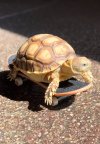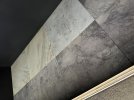JacobK
New Member
Putting my baby Charlie into a 4x2x2 PVC sealed enclosure today. CHE on a thermostat, incandescent basking lamp & UVB strip bulb on a timer, orchid bark substrate, hides and planter plate as water bowl. My question is how do I maintain the correct humidity of 80%, and is there a way to automate it?
Also if anyone has wattage recommendations for CHE & Incandescent basking bulb for this size enclosure since it's a pretty standard size, I would love to know what has worked for you! Thanks in advance! attached are some pictures of Charlie aka Charles.
He is barely 2 inches. Eating a lot, pooping, moving and grooving. The biggest enclosure I can possibly keep in my downtown los angeles loft apartment is 8x2x2, so I know I will have to rehome him someday, but I did rescue him and I feel like I want to at least give him the best year or 2 I can and make sure he grows beyond his fragile baby stage. Looking forward to creating some connections on this forum here and sharing Charlies progress as well as having any questions answered along the way. Thank you all!
Also if anyone has wattage recommendations for CHE & Incandescent basking bulb for this size enclosure since it's a pretty standard size, I would love to know what has worked for you! Thanks in advance! attached are some pictures of Charlie aka Charles.
He is barely 2 inches. Eating a lot, pooping, moving and grooving. The biggest enclosure I can possibly keep in my downtown los angeles loft apartment is 8x2x2, so I know I will have to rehome him someday, but I did rescue him and I feel like I want to at least give him the best year or 2 I can and make sure he grows beyond his fragile baby stage. Looking forward to creating some connections on this forum here and sharing Charlies progress as well as having any questions answered along the way. Thank you all!



